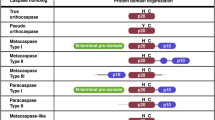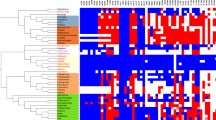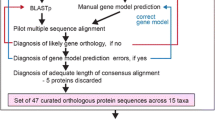Abstract
Programmed cell death (PCD) represents a significant component of normal growth and development in multicellular organisms. Recently, PCD-like processes have been reported in single-celled eukaryotes, implying that some components of the PCD machinery existed early in eukaryotic evolution. This study provides a comparative analysis of PCD-related sequences across more than 50 unicellular genera from four eukaryotic supergroups: Unikonts, Excavata, Chromalveolata, and Plantae. A complex set of PCD-related sequences that correspond to domains or proteins associated with all main functional classes—from ligands and receptors to executors of PCD—was found in many unicellular lineages. Several PCD domains and proteins previously thought to be restricted to animals or land plants are also present in unicellular species. Noteworthy, the yeast, Saccharomyces cerevisiae—used as an experimental model system for PCD research, has a rather reduced set of PCD-related sequences relative to other unicellular species. The phylogenetic distribution of the PCD-related sequences identified in unicellular lineages suggests that the genetic basis for the evolution of the complex PCD machinery present in extant multicellular lineages has been established early in the evolution of eukaryotes. The shaping of the PCD machinery in multicellular lineages involved the duplication, co-option, recruitment, and shuffling of domains already present in their unicellular ancestors.



Similar content being viewed by others
References
Al-Olayan EM, Williams GT, Hurd H (2002) Apoptosis in the malaria protozoan, Plasmodium berghei: a possible mechanism for limiting intensity of infection in the mosquito. Int J Parasitol 32:1133–1143
Altschul SF, Gish W, Miller W, Myers EW, Lipman DJ (1990) Basic local alignment search tool. J Mol Biol 215:403–410
Altschul SF, Madden TL, Schaffer AA, Zhang JH, Zhang Z, Miller W, Lipman DJ (1997) Gapped BLAST and PSI-BLAST: a new generation of protein database search programs. Nucleic Acids Res 25:3389–3402
Ambit A, Fasel N, Coombs GH, Mottram JC (2008) An essential role for Leishmania major metacaspase in cell cycle progression. Cell Death Diff 15:113–122
Ameisen JC, Idziorek T, Billautmulot O, Loyens M, Tissier JP, Potentier A, Ouaissi A (1995) Apoptosis in a unicellular eukaryote (Trypanosoma cruzi)—implications for the evolutionary origin and role of programmed cell-death in the control of cell-proliferation, differentiation and survival. Cell Death Differ 2:285–300
Aravind L, Dixit VM, Koop B (1999) The domains of death: evolution of the apoptosis machinery. Trends Biochem Sci 24:47–53
Aravind L, Watanabe H, Lipman DJ, Koonin EV (2000) Lineage-specific loss and divergence of functionally linked genes in eukaryotes. Proc Natl Acad Sci USA 97:11319–11324
Aravind L, Dixit VM, Koonin EV (2001) Apoptotic molecular machinery: vastly increased complexity in vertebrates revealed by genome comparisons. Science 291:1279–1284
Arnoult D, Akarid K, Grodet A, Petit PX, Estaquier J, Ameisen JC (2002) On the evolution of programmed cell death: apoptosis of the unicellular eukaryote Leishmania major involves cysteine proteinase activation and mitochondrion permeabilization. Cell Death Differ 9:65–81
Balk J, Chew SK, Leaver CJ, McCabe PF (2003) The intermembrane space of plant mitochondria contains a DNase activity that may be involved in programmed cell death. Plant J 34:573–583
Bidle KD, Bender SJ (2008) Iron starvation and culture age activate metacaspases and programmed cell death in the marine diatom Thalassiosira pseudonana. Eukaryot cell 7:223–236
Bidle KD, Falkowski PG (2004) Cell death in planktonic, photosynthetic microorganisms. Nat Rev Microbiol 2:643–655
Bidle KD, Haramaty L, Barcelos E, Ramos J, Falkowski P (2007) Viral activation and recruitment of metacaspases in the unicellular coccolithophore, Emiliania huxleyi. Proc Natl Acad Sci USA 104:6049–6054
Brinkmann U (1998) CAS, the human homologue of the yeast chromosome-segregation gene CSE1, in proliferation, apoptosis, and cancer. Am J Hum Genet 62:509–513
Brinkmann U, Brinkmann E, Gallo M, Pastan I (1995) Cloning and characterization of a cellular apoptosis susceptibility gene, the human homologue to the yeast chromosome segregation gene CSE1. Proc Natl Acad Sci USA 92:10427–10431
Buettner S, Eisenberg T, Carmona-Gutierrez D, Ruli D, Knauer H, Ruckenstuhl C, Sigrist C, Wissing S, Kollroser M, Froehlich KU, Sigrist S, Madeo F (2007) Endonuclease G regulates budding yeast life and death. Mol Cell 25:233–246
Cavalier-Smith T (2002) The phagotrophic origin of eukaryotes and phylogenetic classification of Protozoa. Int J Syst Evol Microbiol 52:297–354
Chae HJ, Ke N, Kim HR, Chen SR, Godzik A, Dickman M, Reed JC (2003) Evolutionarily conserved cytoprotection provided by Bax Inhibitor-1 homologs from animals, plants, and yeast. Gene 323:101–113
Cornillon S, Foa C, Davoust J, Buonavista N, Gross JD (1994) Programmed cell death in Dictyostelium. J Cell Sci 107:2691–2704
Deponte M (2008a) Programmed cell death in protists. Biochim Biophys Acta Mol Cell Res 1783:1396–1405
Deponte M (2008b) In search of Atropos’ scissors: severing the life-thread of Plasmodium. In: Pérez Martin JM (ed) Programmed cell death in protozoa. Landes Bioscience, Austin, pp 91–96
DeValck D, Heyninck K, VanCriekinge W, Contreras R, Beyaert R, Fiers W (1996) A20, an inhibitor of cell death, self-associates by its zinc finger domain. FEBS Lett 384:61–64
Devoto A, Piffanelli P, Nilsson I, Wallin E, Panstruga R, von Heijne G, Schulze-Lefert P (1999) Topology, subcellular localization, and sequence diversity of the Mlo family in plants. J Biol Chem 274:34993–35004
Dimmer KS, Fritz S, Fuchs F, Messerschmitt M, Weinbach N, Neupert W, Westermann B (2002) Genetic basis of mitochondrial function and morphology in Saccharomyces cerevisiae. Mol Biol Cell 13:847–853
Doong H, Vrailas A, Kohn EC (2002) What’s in the ‘BAG’? A functional domain analysis of the BAG-family proteins. Cancer Lett 188:25–32
Edgar RC (2004) MUSCLE: a multiple sequence alignment method with reduced time and space complexity. BMC Bioinformatics 5:1–19
Ekert PG, Vaux DL (2005) The mitochondrial death squad: hardened killers or innocent bystanders? Curr Opin Cell Biol 17:626–630
Embley TM, Martin W (2006) Eukaryotic evolution, changes and challenges. Nature 440:623–630
Fahrenkrog B, Sauder U, Aebi U (2004) The S-cerevisiae HtrA-like protein Nma111p is a nuclear serine protease that mediates yeast apoptosis. J Cell Sci 117:115–126
Gonzalez IJ, Desponds C, Schaff C, Mottram JC, Fasel N (2007) Leishmania major metacaspase can replace yeast metacaspase in programmed cell death and has arginine-specific cysteine peptidase activity. Int J Parasitol 37:161–172
Gumienny TL, Brugnera E, Tosello-Trampont AC, Kinchen JM, Haney LB, Nishiwaki K, Walk SF, Nemergut ME, Macara IG, Francis R, Schedl T, Qin Y, Van Aelst L, Hengartner MO, Ravichandran KS (2001) CED-12/ELMO, a novel member of the crkII/dock180/rac pathway, is required for phagocytosis and cell migration. Cell 107:27–41
Helms MJ, Ambit A, Appleton P, Tetley L, Coombs GH, Mottram JC (2006) Bloodstream form Trypanosoma brucei depend upon multiple metacaspases associated with RAB11-positive endosomes. J Cell Sci 119:1105–1117
Helton ES, Chen XB (2007) p53 modulation of the DNA damage response. J Cell Biochem 100:883–896
Huckelhoven R (2004) BAX Inhibitor-1, an ancient cell death suppressor in animals and plants with prokaryotic relatives. Apoptosis 9:299–307
Jacobson MD, Weil M, Raff MC (1997) Programmed cell death in animal development. Cell 88:347–354
Jung YS, Kim KS, Kim KD, Lim JS, Kim JW, Kim E (2001) Apoptosis-linked gene 2 binds to the death domain of Fas and dissociates from Fas during Fas-mediated apoptosis in Jurkat cells. Biochem Biophys Res Commun 288:420–426
Keeling PJ, Burger G, Durnford DG, Lang BF, Lee RW, Pearlman RE, Roger AJ, Gray MW (2005) The tree of eukaryotes. Trends Ecol Evol 20:670–676
Kim MC, Lee SH, Kim JK, Chun HJ, Choi MS, Chung WS, Moon BC, Kang CH, Park CY, Yoo JH, Kang YH, Koo SC, Koo YD, Jung JC, Kim ST, Schulze-Lefert P, Lee SY, Cho MJ (2002) Mlo, a modulator of plant defense and cell death, is a novel calmodulin-binding protein—isolation and characterization of a rice Mlo homologue. J Biol Chem 277:19304–19314
King N (2004) The unicellular ancestry of animal development. Dev Cell 7:313–325
Koonin EV, Aravind L (2000) The NACHT family—a new group of predicted NTPases implicated in apoptosis and MHC transcription activation. Trends Biochem Sci 25:223–224
Koonin EV, Aravind L (2002) Origin and evolution of eukaryotic apoptosis: the bacterial connection. Cell Death Differ 9:394–404
Krebs J, Saremaslani P, Caduff R (2002) ALG-2: a Ca2+-binding modulator protein involved in cell proliferation and in cell death. Biochim Biophys Acta 1600:68–73
Lam E (2004) Controlled cell death, plant survival and development. Nat Rev Mol Cell Biol 5:305–315
Lehar SM, Nacht M, Jacks T, Vater CA, Chittenden T, Guild BC (1996) Identification and cloning of EI24, a gene induced by p53 in etoposide-treated cells. Oncogene 12:1181–1187
Li LY, Luo L, Wang XD (2001) Endonuclease G is an apoptotic DNase when released from mitochondria. Nature 412:95–99
Liu HT, Wang YG, Zhang YM, Song QS, Di CH, Chen GH, Tang J, Ma DL (1999) TFAR19, a novel apoptosis-related gene cloned from human leukemia cell line TF-1, could enhance apoptosis of some tumor cells induced by growth factor withdrawal. Biochem Biophys Res Commun 254:203–210
Lufei CC, Ma J, Huang GC, Zhang T, Novotny-Diermayr V, Ong CT, Cao XM (2003) GRIM-19, a death-regulatory gene product, suppresses Stat3 activity via functional interaction. EMBO J 22:1325–1335
Madeo F, Frohlich E, Ligr M, Grey M, Sigrist SJ, Wolf DH, Frohlich KU (1999) Oxygen stress: a regulator of apoptosis in yeast. J Cell Biol 145:757–767
Madeo F, Herker E, Maldener C, Wissing S, Lachelt S, Herian M, Fehr M, Lauber K, Sigrist SJ, Wesselborg S, Frohlich KU (2002) A caspase-related protease regulates apoptosis in yeast. Mol Cell 9:911–917
Mendoza L, Orozco E, Rodriguez MA, Garcia-Rivera G, Sanchez T, Garcia E, Gariglio P (2003) Ehp53, an Entamoeba histolytica protein, ancestor of the mammalian tumour suppressor p53. Microbiology 149:885–893
Modjtahedi N, Giordanetto F, Madeo F, Kroemer G (2006) Apoptosis-inducing factor: vital and lethal. Trends Cell Biol 16:264–272
Moharikar S, D’Souza JS, Kulkarni AB, Rao BJ (2006) Apoptotic-like cell death pathway is induced in unicellular chlorophyte Chlamydomonas reinhardtii (Chlorophyceae) cells following UV irradiation: detection and functional analyses. J Phycol 42:423–433
Moharikar S, D’Souza JS, Rao BJ (2007) A homologue of the defender against the apoptotic death gene (dad1) in UV-exposed Chlamydomonas cells is downregulated with the onset of programmed cell death. J Biosci 32:261–270
Mottram JC, Helms MJ, Coombs GH, Sajid M (2003) Clan CD cysteine peptidases of parasitic protozoa. Trends Parasitol 19:182–187
Nakashima T, Sekiguchi T, Kuraoka A, Fukushima K, Shibata Y, Komiyama S, Nishimoto T (1993) Molecular-cloning of a human Cdna-encoding a novel protein, Dad1, whose defect causes apoptotic cell-death in hamster Bhk-21-cells. Mol Cell Biol 13:6367–6374
Nedelcu AM (2006) Evidence for p53-like-mediated stress responses in green algae. FEBS Lett 580:3013–3017
Nedelcu A, Tan C (2007) Early diversification and complex evolutionary history of the p53 tumor suppressor gene family. Dev Genes Evol 216:801–806
Nedelcu AM, Miles IH, Fagir AM, Karol K (2008) Adaptive eukaryote-to-eukaryote lateral gene transfer: stress-related genes of algal origin in the closest unicellular relatives of animals. J Evol Biol 21:1852
Park WR, Nakamura Y (2005) p53CSV, a novel p53-inducible gene involved in the p53-dependent cell-survival pathway. Cancer Res 65:1197–1206
Sadoul M (2006) Do Alix and ALG-2 really control endosomes for better or for worse? Biol Cell 98:69–77
Schultz J, Milpetz F, Bork P, Ponting CP (1998) SMART, a simple modular architecture research tool: Identification of signaling domains. Proc Natl Acad Sci USA 95:5857–5864
Segovia M, Haramaty L, Berges JA, Falkowski PG (2003) Cell death in the unicellular chlorophyte Dunaliella tertiolecta. A hypothesis on the evolution of apoptosis in higher plants and metazoans. Plant Physiol 132:99–105
Song HY, Rothe M, Goeddel DV (1996) The tumor necrosis factor-inducible zinc finger protein A20 interacts with TRAF1/TRAF2 and inhibits NF-kappa B activation. Proc Natl Acad Sci USA 93:6721–6725
Stechmann A, Cavalier-Smith T (2003) The root of the eukaryote tree pinpointed. Curr Biol 13:R665–R666
Tewari M, Yu M, Ross B, Dean C, Giordano A, Rubin R (1997) AAC-11, a novel cDNA that inhibits apoptosis after growth factor withdrawal. Cancer Res 57:4063–4069
Uren AG, Beilharz T, O’Connell MJ, Bugg SJ, van Driel R, Vaux DL, Lithgow T (1999) Role for yeast inhibitor of apoptosis (IAP)-like proteins in cell division. Proc Natl Acad Sci USA 96:10170–10175
Uren AG, O’Rourke K, Aravind L, Pisabarro MT, Seshagiri S, Koonin EV, Dixit VM (2000) Identification of paracaspases and metacaspases: two ancient families of caspase-like proteins, one of which plays a key role in MALT lymphoma. Mol Cell 6:961–967
van der Biezen EA, Jones JDG (1998) The NB-ARC domain: a novel signalling motif shared by plant resistance gene products and regulators of cell death in animals. Curr Biol 8:R226–R227
Vardi A, Berman-Frank I, Rozenberg T, Hadas O, Kaplan A, Levine A (1999) Programmed cell death of the dinoflagellate Peridinium gatunense is mediated by CO2 limitation and oxidative stress. Curr Biol 9:1061–1064
Vaux DL, Hacker G (1995) Cloning of mouse Rp-8 Cdna and its expression during apoptosis of lymphoid and myeloid cells. DNA Cell Biol 14:189–193
Vercammen D, Declercq W, Vandenabeele P, Van Breusegem F (2007) Are metcaspases caspases? J Cell Biol 179:375–380
Walter D, Wissing S, Madeo F, Fahrenkrog B (2006) The inhibitor-of-apoptosis protein Bir1p protects against apoptosis in S. cerevisiae and is a substrate for the yeast homologue of Omi/HtrA2. J Cell Sci 119:1843–1851
Wissing S, Ludovico P, Herker E, Buttner S, Engelhardt SM, Decker T, Link A, Proksch A, Rodrigues F, Corte-Real M, Frohlich KU, Manns J, Cande C, Sigrist SJ, Kroemer G, Madeo F (2004) An AIF orthologue regulates apoptosis in yeast. J Cell Biol 166:969–974
Yang A, Kaghad M, Caput D, McKeon F (2002) On the shoulders of giants: p63, p73, and the rise of p53. Trends Genet 18:90–95
Yoon HS, Grant J, Tekle YI, Wu M, Chaon BC, Cole JC, Logsdon JM Jr, Patterson DJ, Bhattacharya D, Katz LA (2008) Broadly sampled multigene trees of eukaryotes. BMC Evol Biol 8:14
Zuppini A, Andreoli C, Baldan B (2007) Heat stress: an inducer of programmed cell death in Chlorella saccharophila. Plant Cell Physiol 48:1000–1009
Acknowledgments
This research was supported by a Discovery Grant from the Natural Sciences and Engineering Research Council (NSERC) of Canada to A.M.N. Many of the sequences analyzed in this study were produced by the U.S. Department of Energy Joint Genome Institute (http://www.jgi.doe.gov/) and the Protist EST Program (http://amoebidia.bcm.umontreal.ca/pepdb/) and are provided for use in this publication only.
Author information
Authors and Affiliations
Corresponding author
Electronic supplementary material
Below is the link to the electronic supplementary material.
Rights and permissions
About this article
Cite this article
Nedelcu, A.M. Comparative Genomics of Phylogenetically Diverse Unicellular Eukaryotes Provide New Insights into the Genetic Basis for the Evolution of the Programmed Cell Death Machinery. J Mol Evol 68, 256–268 (2009). https://doi.org/10.1007/s00239-009-9201-1
Received:
Revised:
Accepted:
Published:
Issue Date:
DOI: https://doi.org/10.1007/s00239-009-9201-1




